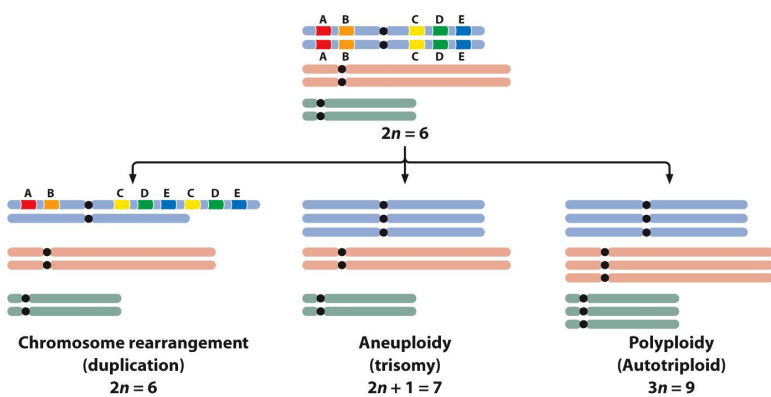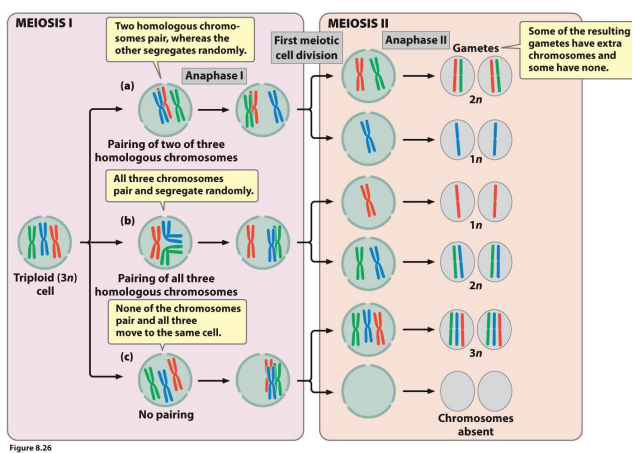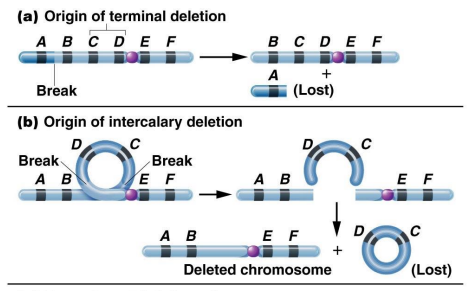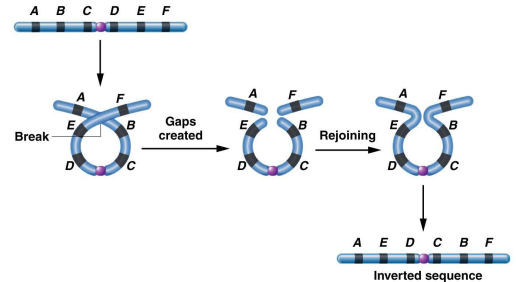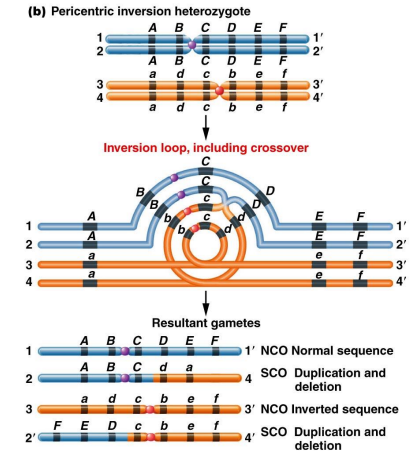Chromosomal Mutations
Vocabulary:
Short arm (p): Part of a chromosome visually, shorter end of the centromere, placed on top in a karyotype
Long arm (q): Part of a chromosome visually, longer end of the centromere
Metacentric: When the centromere is in the middle of the chromosome
Submetacentric: When the centromere is more towards one side than the other
Acrocentric: When most of the chromosome is on one side of the centromere
Telocentric: When the centromere is on the edge of the chromosome
Banding: Created by the staining of chromosomes, can be used to distinguish homologous pairs
Giemsa stain: Provides dark/light banding
Q bands: Created by fluorescent staining using quinacrine mustard
Aneuploidy: A mutation in the number of total chromosomes, written as 2n+1 with an extra
Polyploidy: A mutation where there are one or more extra full sets of chromosomes, written as 3n when 3 full sets
Monosomy: Loss of a single chromosome in diploid genomes
Trisomy: Gain of a single chromosome in the diploid genome
Euploidy: Typical chromosomes, one complete haploid set
Triploidy: When there are three full sets of chromosomes
Disomy: When an organism has 2n chromosomes, can be biparental or not
Nondisjunction: When a chromosome/chromatids fail to disjoin and move to opposite poles during meiosis I or II
Pseudodominance: Occurs due to a monosomy of a recessive allele, one copy is enough for it to be displayed
Haploinsufficiency: When a monosomy isn’t sufficient enough for an organism to survive, as enough genetic product isn’t being produced
Down syndrome: Caused by trisomy of chromosome 21 in humans, has 12 phenotypes but only 6-8 are typically displayed, can have a flat face, low muscle, short height, higher risk for cataracts, heart defects/immune disorders, intellectual disabilities. More likely the older the mother is, occurs in meiosis I
Familial down syndrome: A Robertsonian translocation of the trisomic 21 chromosome onto the 14 chromosome, can be inherited though not displayed, can “pass down syndrome” on to children
Patau syndrome: Trisomy of chromosome 13, fatal within early years of life
Edwards syndrome: Trisomy of chromosome 18, fatal within early years of life
Autopolyploidy: Polyploidy due to nondisjunction within a species
Allopolyploidy: Polyploidy coming from fertilization from different species, forming a hybrid, viable offspring are more common with closely related species, though often infertile
Unbalanced gamete: Tends to come from having an odd number of chromosomes in polyploidy, typically nonviable due to dosage compensation not working
Colchicine: A chemical that can induce autotetraploids to form from diploids, used often in crops
Amphidiploid: Happens when a sterile hybrid doubles its chromosomes (spontaneously or induced by colchicine), becomes fertile. This is often done with plants, the parents are known
Deficiency: The missing piece of a chromosome that has broken and lost a portion in at least 1 place, can lead to haploinsufficiency or pseudodominance
Terminal deletion: A deficiency near one end
Intercalary deletion: A deficiency on the interior of the chromosome
Cri-du-chat: A mutation that results from a segmental deletion of a small terminal portion of the p arm of chromosome 5
Gene redundancy: When an organism has multiple copies of the same gene, for example rRNA
Gene amplification: Increases levels of rRNA, oocytes store nutrients such as ribosomes, redundant gene copying
Duplication: When two copies of a gene are present that shouldn’t be, typically only one
Gene family: A regional group or genes whose products perform the same or similar general functions
Inversion: A rearrangement of the linear gene sequence, no loss of genetic information. Chromosome is turned around 180 degrees, requires two breaks to occur with a reinsertion after the segment flips, can occur due to looping
Paracentric inversion: An inversion that doesn’t change the relative length of p and q arms
Pericentric inversion: An inversion that contains the centromere, ends up changing the length of p and q arms
Inversion loop: Required to form for chromosomes to invert, if crossing over occurs gametes will have problems
Dicentric: Describes a chromosome that has 2 centromeres due to crossing over during an inversion
Acentric: Describes a chromosome that has no centromere due to crossing over during an inversion
Translocation: A movement of a chromosomal segment to a new location in the genome
Reciprocal translocation: The exchange of segments between two nonhomologous chromosomes, has an unusual synapse configuration during meiosis
Alternate segregation: Leads to normal and balanced gamete formation, even after translocation
Adjacent segregation: Leads to gametes containing duplications and deficiencies after translocation
Robertsonian translocation (centric fusion): Involves breaks at extreme ends of the p arms or 2 nonhomologous acrocentric chromosomes, leads to small segment loss and fusion of the larger segments
Fragile site: A region of a chromosome more susceptible to chromosome breakage
Fragile-X syndrome (FXS): Common inherited intellectual disability, dominant and involves fragile site FMR1 is lost
Genetic anticipation: When the number of irregular trinucleotide repeats increase with generations, seen in FXS
